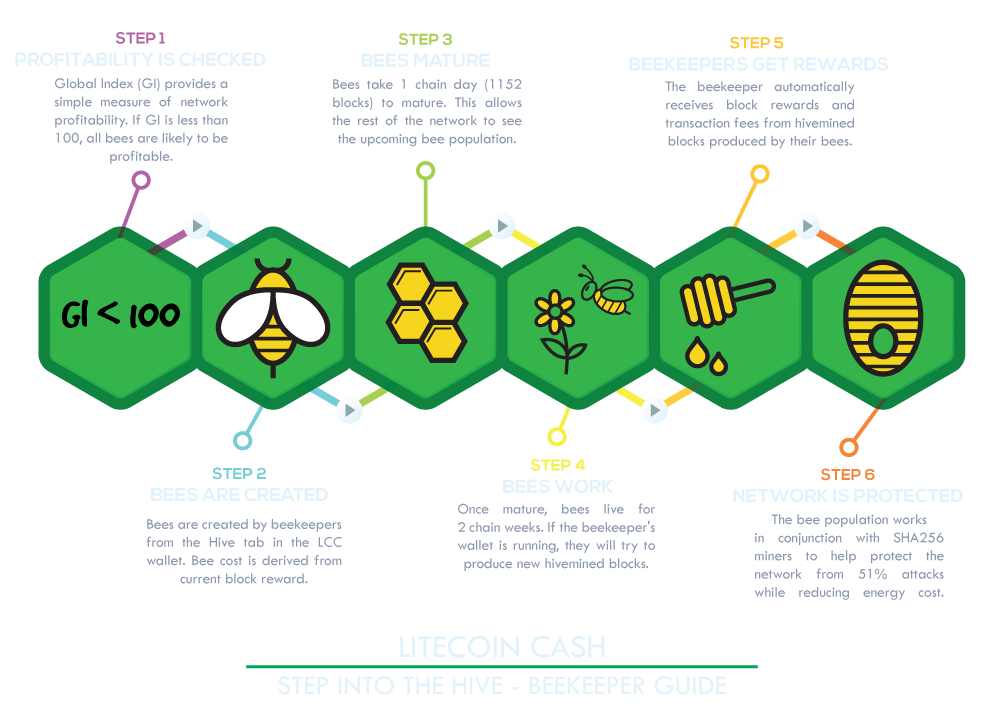Guide to Hive mining

Hive Mining Basics
Hivemining allows any LCC holder to try and mine blocks and secure the blockchain, without needing any special hardware and at extremely low energy cost.
From the Hive tab in the core wallet, you can spend LCC to create worker bees -- mining agents which live inside the blockchain and work to extend the chain while earning block rewards for you, the beekeeper.

The bee cost is calculated as a percentage of current block reward, and will only change at reward halvening.
You can create as many bees at once as you like, but note that funds spent to create bees are lost forever.
Before creating bees, you should check the indicated Global Index is less than 100, to ensure likely profitability; see here for more information about the Global Index.

LCC spent creating bees is destroyed - it's literally lost forever. Bee creation fees are not sent to the devteam, or anyone else. However, you can optionally choose to instead donate 10% of the bee creation cost to a community fund which helps fund further development. This is completely optional and makes no difference to the total cost you pay or the number of bees you get.
Once you've created your bees and the creation transaction has appeared in a block, your bees will be displayed in the "Your Hive" section of the Hive tab.

After creation, bees take 1,152 blocks to mature (approximately 24 hours of chain time). During this time, your wallet does not need to be online; the bees will mature regardless.
After the maturation period, bees live for 16,128 blocks (approximately 2 weeks). During this time, your wallet should remain online as much as possible; your bees can only work for you while your wallet is connected to the network.
While your bees are alive and your wallet is online, your bees will attempt to produce a new hivemined block every time they observe a new incoming proof-of-work block; hivemined blocks must always follow proof-of-work blocks. This mining attempt takes only a fraction of a second even for large hives, and shouldn't cause any lag or lock-up of your computer. Energy usage is negligible.
If your bees manage to successfully mine a block, your wallet will receive the block rewards (as well as any transaction fees in the block) just as if you were a proof-of-work miner.
Network hive difficulty automatically adjusts to the current bee population so that generally, only one bee in the whole network will succeed at hivemining a given block. However, orphan blocks do occur if more than one bee succeeds in mining a block at the same height. They are expected, and are nothing to worry about. In the case of your bees managing to mine a block but another bee managing to as well, you may see "Generated but not accepted" block rewards shown in the Transactions tab. Note that only confirmed block rewards are shown on the Hive tab; rewards will never disappear after being shown there.

On the Hive tab, a widget at the bottom-left displays your hive weight. This fraction represents the amount of the current bee population that you control. For example, if you have 1000 bees and there are 10000 bees in total alive across the network, your hive weight will be 0.100, indicating you control 10% of the network. As well as a measure of your share of the network, this fraction is also the probability that your hive will be able to solve any given hivemine-eligible block.

Note that if your wallet is offline during the working lifespan of your bees, they will be unable to attempt to mine blocks, but their lifespan will still decrease as other miners extend the blockchain.
At the very bottom-right of the wallet, a hexagonal Hive status icon (second from right) indicates that your bees are mature and working by showing green. For any other colour, please mouseover the icon for additional info.

For more detailed information, please read our whitepaper:
The Hive: Agent-Based Mining in Litecoin Cash